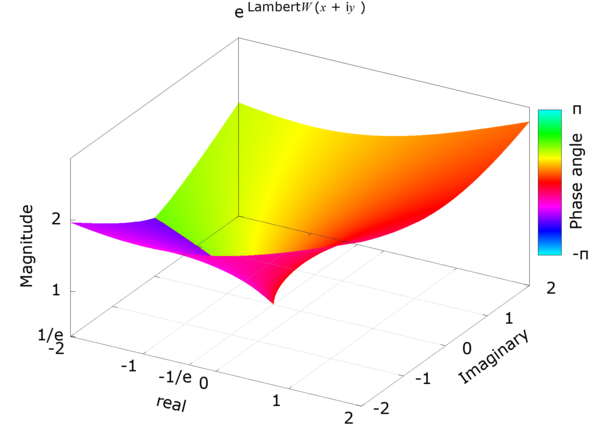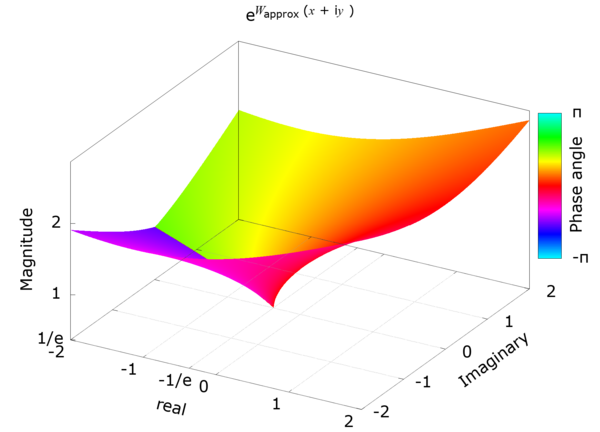

From the relation below, the Lambert W can be calculated by using eW — the exponent of Lambert W — as ln(eW(x)) or x / eW(x).
eW0(x) — the exponent of the principal branch of the Lambert W function W0(x) — can be calculated by using Newton-Raphson method,
or equivalent and simpler, but slightly less accurate recurrence formula below.
If you try to find e W0 (x) for x that is very close to -1 / e i.e. singularity, with Newton-Raphson method, it would go bad from a convergence point of view. So, it is desirable that the approximation error of the initial value is asymptotic to 0 at -1 / e. For that reason, I chose the following formula as an approximate expression that gives the initial value.
Instead of the coefficient of 0.3 in the formula above, it can be "e - √2 - 1" which makes zero error at x = 0, or "1 / 3" from Puiseux series, but 0.3 is quite good enough for this purpose.
It's nice to be able to handle complex numbers easily with 42S, and thanks to SQRT √ in this equation, 42S can automatically get the complex y0 from x less than -1 / e.
Download 'eW-1.4.raw' for Free42 or DM42
eW - Rev.1.4 (Oct. 6 2020) eW - calculate e W0 (x) Rev.1.4 (Oct. 6 2020) (c) Takayuki HOSODA, Albert Chan, Werner Huysegoms Input X : x Output Z : x Y : e W 0 ( x ) X : e W 0 ( x ) Recurrence formula (Newton method) :Initial approximation :


00 { 53-Byte Prgm } 01▶LBL "eW" 02 0.3 03 -1 04 E↑X 05 RCL+ ST Z 06 STO× ST Y 07 STO+ ST X 08 LASTX 09 STO+ ST Z 10 × 11 SQRT 12 + 13 X<>Y 14 +/- 15 X<>Y # Initial value 16▶LBL 01 17 X=Y? # Convergence check 18 RTN 19 STO ST Y 20 LN 21 1 22 + 23 R↑ 24 RCL+ ST Z 25 X<>Y 26 ÷ # Newton-Raphson method 27 - 28 STO× ST X 29 LASTX 30 STO+ ST Y 31 GTO 01 32 .END.
Acknowledgments
- Thanks to Werner of the hpmuseum forum for his advice on reducing the code by several bytes :-)
- Thanks to Albert Chan of the hpmuseum forum for extending the code to accept complex input :-)
For more informationsDBL_MAX := 1.7976931348623157E+308 M_E := 2.7182818284590452354 M_1_E := 0.36787944117144232160 exp(lambertw(2.7182818284590452354)) ≈ 2.718281828459045235380143735676331 exp(lambertw(1 -2 * I)) ≈ 1.963022024795710615403657609352963 - 1.157904818620494603558662182506434 * I exp(lambertw(1)) ≈ 1.763222834351896710225201776951707 exp(lambertw(I)) ≈ 1.219531415904638290761849581476316 + 0.79276048053626614951364590110420540 * I exp(lambertw(0)) ≈ 1 exp(lambertw(-0.36)) ≈ 0.44660340471508799282336704382334493 exp(lambertw(-0.36787944117144232160)) ≈ 0.3678794411714423215940316935486145 + 5.738837742185627565654911654550658e-11 * I exp(lambertw(-0.37)) ≈ 0.36717276900330783668441776919458851 + 0.039505937830337093378017782321873547 * I exp(lambertw(-1)) ≈ 0.16837637908722291055702904019641980 +0.70775418878472761647284589307651624 * I exp(lambertw(-1.78)) ≈ -0.059913754741825131012618862446014644 + 1.0916761607000236604411601478529583 * I exp(lambertw(-6 + 8 * I)) ≈ 0.5264016089780162506063934272535399 + 4.672167782982315920355097205014711 * I exp(lambertw(-1e40+ 1e40 * I)) ≈ -1.105839096727961926761463409591397e38 + 1.166002733393463635466614023256946e38 * I exp(lambertw(1e99)) ≈4.493356750426821622552404615870473886e96 exp(lambertw(DBL_MAX / 2048)) ≈ 1.261879051192686334779289930192228092e302 exp(lambertw(DBL_MAX / 1024)) ≈ 2.521249396109343724237771081311131912e302 exp(lambertw(DBL_MAX / 1024 * (1 + I))) ≈ 2.522830663716190666378256473298873041e302 + 2.517156775366979709124816162156298866e302 * I exp(lambertw(-DBL_MAX / 1024 * (1 + I))) ≈ -2.511457441673898564070201945759970065e302 + 2.528478934471466911545439081960013883e302 * I exp(lambertw(-DBL_MAX / 1024)) ≈ -2.521198257475903786620327462027548275e302 + 1.135883576664975088461252871876537019e300 * I exp(lambertw(DBL_MAX / 512)) ≈ 5.037491337606633333196094048616224613e302 exp(lambertw(DBL_MAX / 256)) ≈ 1.006498762266630559657258456161750187e303 exp(lambertw(DBL_MAX / 128)) ≈ 2.011002473565593500923176245177799597e303 exp(lambertw(DBL_MAX / 4)) ≈ 6.403475847440308183677482911752527470e304 exp(lambertw(DBL_MAX / 2)) ≈ 1.279433384662740296920509547057383184e305 exp(lambertw(DBL_MAX)) ≈ 2.556348163871690389301867464319449906e305 exp(lambertw(-DBL_MAX)) ≈ -2.55629732717928176150546584430620958e305 + 1.14037728103254468762927980248285270e303 * I exp(lambertw( DBL_MAX + DBL_MAX * I)) ≈ 2.557935739687930990678357670308497539e305 + 2.552239351260206850940540465216562109e305 * I exp(lambertw(-DBL_MAX + DBL_MAX * I)) ≈ -2.546517666521172009117885938485236756e305 + 2.563606662249022010249963578079392704e305 * I exp(lambertw(DBL_MAX * I)) ≈ 5.70197134852380166291426603783285580e302 + 2.55633545450941131201825034698564095e305 * I
